Pernille Ripp's Blog, page 61
January 27, 2016
A Simple Choice Really
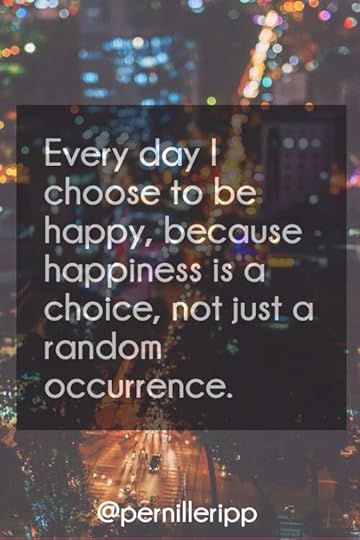
For the past three nights, our 3 year old twins have been sick. Between runny noses, fevers, coughs and the inevitable lost teddy bears, my nights have been punctuated by short bursts of sleep and morning has been oh so heavy. It is often when we are physically drained that we find we have no reserves for anything else. That we become robots simply trying to get through our days. No wonder sleep deprivation is a known torture method.
For the past three days, it seems school has also been filled with turmoil. With major decisions and discussions. With emotions and low points. With short tempers and misunderstandings, all minor but when looked upon as a whole, the weight can seem unbearable.
And yet, every day has been a good one. Every day has been filled with more good than bad, more positive than otherwise. And it is not by happenstance or blissful ignorance, but by choice. Pure and simple.
Because we are all busy.
Because we are all faced with hardship.
Because we are all tired or sick or just a little bit emotional.
And we all have a choice to make.
Do we choose to spend our time wallowing in our low points or do we look for the good to carry us through?
I could have raged more.
I could have cried more.
I could have had my feelings more hurt, but in the end, I chose to get over it. To not make the bad the focal point but rather just a small point in my day long journey. To not forget, because we know we wont, but to move past it and find other things to spend my limited energy on.
As educators we have more good days than bad, but we also have a choice to make. Do we continue to look for the good? To care about the things we can change? Or do we focus on all the negative, on all the things out of our hands? Because there are plenty of things we could let tear us apart.
So tonight as I write this through my muddled thoughts; it is as a reminder to myself; the road will always be rocky. The day will always be filled with emotions. But the choice to stay positive and look for solutions rather than problems is one I can make. Is one I can take. And that’s what I intend to keep doing, how about you?
If you like what you read here, consider reading my book Passionate Learners – How to Engage and Empower Your Students. Also, if you are wondering where I will be in the coming year or would like to have me speak, please see this page.
Filed under: being a teacher, being me


January 26, 2016
How to Make Grades About Students Again

Our first semester ended last week. I have been working on grades, both standards scores and letter grades, for the past 3 days. Pondering. Wondering. Pulling my hair out as I try to figure out which box to place my students in as we try to assess the growth that has happened. In the end of it all, I am reminded of how much I still hate grades.
And yet, within this process of distilling my students down to a single letter comes an amazing opportunity for conversation. Within the very simplification of all of the learning they have done, we have had an awesome chance to change the notion of what that score or letter means.
So how can we make grades and scores about the students again?
Start with a student definition. Our very first conversation was the definition of each letter grade; a seemingly simple topic of conversation that shows just what students think grades measure; hard work, effort, being able to follow deadlines. Very few students really understood that grades are supposed to measure knowledge. Not work habits. Not personalities. In fact, many students said that the teacher is who is in control of grades (which, of course, there is an ounce of truth in) but they had never thought about how they could control the score. How the choices they make result in the score they get. The light-bulb moment for some students was tangible.
Have them grade themselves. And not just for fun, but really. After each grading period, my students either write which standard score they should get and why or which letter grade and why. This very simple act – it takes about 5 minutes – become the seeds of conversations we need to have next.
Have them do a semester survey. I continually want to be a better teacher for my students and that means that I need to face some ugly truths; some students are not getting enough help, some students feel I talk too much, some students are still not reading but getting very good at faking it. How do I know? I asked them on our end of semester survey and they told me their truths.
Ask them what they are proud of. As students came up one-by-one, this was the very first question I asked. Not what their grade should be, not what their goal is. But what are they proud of. Why that? What else? Then what are goals? How can I help best? How can I support? I read their survey and we discussed things right then. Their voices came first, not their score.
Then discuss their grades. The majority of students had picked the same letter I would, but some had either scored themselves too high or too low. And while this is always interesting to see, the bigger truth can be found in why they have picked that letter to define them. Those simple statements they use to explain their answer; I am not that smart, I don’t understand, I work hard, I can teach others. All clues to how they see themselves and their own learning. All clues we can use to change the very essence of the conversation, because the conversation cannot just be about the grade, it needs to be about them. About more than what they are distilled to on paper. About how they see themselves, about their strengths, about their needs, about their dreams.
So while I work in a system that still asks me to define students through a score, we can reclaim that very conversation. We can change the focus of the grade. We can go deeper, make it more meaningful but we have to take the time to do it. We have to assure that students have a voice in the process if we ever want it to be meaningful, if we ever want them to care. We cannot do that through a letter, we cannot even do it through a report card comment. It is not enough. This conversation is the very least we can do to make grades about the students again.
If you like what you read here, consider reading my book Passionate Learners – How to Engage and Empower Your Students. Also, if you are wondering where I will be in the coming year or would like to have me speak, please see this page.
Filed under: assessment, being a teacher, grades, No grades, Student dreams


January 23, 2016
How We Created A Community of Readers
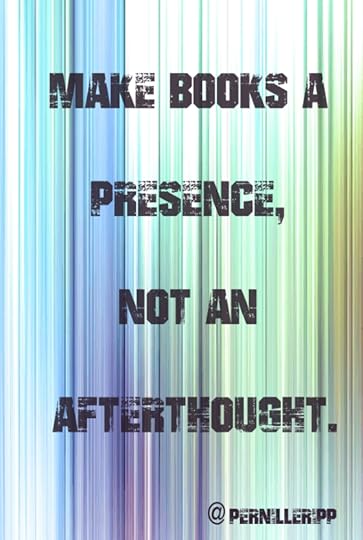
We are a community of readers. It snuck up on us as it usually does. Last week, as my students sat with their chosen reading adventures and I tried to figure out who to confer with, I noticed the silence. That beautiful silence that comes from a large group of kids totally immersed in the task they are doing. The concentration only broken by the quiet ding of the timer. And they came back up for air and I wished that I could give them more than the lousy ten minutes we start with every day.
I know the research and what is says about independent reading. That students, no matter the age, need time every single day to sink into a self-chosen book that will hold their attention and propel them toward better reading. That reading more will make them read more. But I also know that giving them time is not enough.
That all students will not just fall in love with reading simply by someone saying “Read.” That we must be intentional when it comes to building our community of readers in such a way that it does not feel contrived, but will grow on its own.
Many of us who love reading know this, but there are so many more that do not as Donalyn Miller so eloquently writes here. So what is it we need beyond the time? Because the time to read is really just the first step, what else is there to creating a community of readers?
There is a passionate teacher. We must love our books. We must love the act of reading. Students look to us for the passion they may lack and we must live it. We must be the reading role model that some students have never had. And not just the English teachers, but as many adults in a building as possible. Celebrate a culture of reading to show students how reading can enrich all of our lives.
There are high quality books. There is no magic number to how many books a library must have to be considered great, but there is a level of quality that needs to be present. Yes, weeding books can be painful but if students cannot see the books they want to read they will not dig through the piles to find them. Display books like they do in the book store, be mindful of the books that call out to students and change it up.
There must be books in many places. Every classroom should have a classroom library. It does not matter how well-stocked the school library is; students need immediate access to great books so that when their mind wanders and they abandon a book they can get another one right away. Partner with your school librarian; together we are stronger and spread the books out. Put rain gutters up with books for students to grab throughout the school, hold a school wide book drive to get more books in the hands of students, set up a Little Free Library. Make books a presence not an afterthought.
The books are accessible. Too often the systems we put in place, such as the way students check out books, stand in the way of reading. Find out what works for you and make sure it is easy for students. I gave up my checkout system several years ago and now function on trust, I have not regretted it.
There must be choice. And not just choice in what they read, but also choice in where they read and how they read. Audio books have made the biggest difference from some of our most adamant non-readers; they finally have a chance of having rich book conversations like their peers. Allowing students to lie on the floor or get comfortable while reading has helped as well. How many of us choose to read behind a desk when we are at home.
There should be picture books. Picture books are one of the biggest gateways to sustained reading progress in our classroom. Every child can read a picture book, even the ones that say they hate reading.
There should be trust. No more reading logs for all kids to prove that they are reading. No more parent signatures that probably are not truthful anyway.
Reading should be its own reward. No more trinkets, toys, or stickers. No more stars, points, or yo-yos. When a child finishes a book, hand them another book or even better; have them find one on their own.
There should be student talk. Students should have the opportunity to discuss the books they love so much, to hand favorites books to others, to explain why they abandoned a book, to discuss why they may not be reading.
There should be room for all readers. Our emphasis for celebration should be on all of our readers, not just the ones that read the most books or pages. We need to reclaim the term “slow reader” and help students realize that being slow also means that you are careful and that is thing to be proud of.
There should be uninterrupted time to read. Not continual interruptions by the teacher to ask questions or teach another lesson, not a continued quest to get as many post-it notes in our pages read. Let students read and then think. Let students read and then jot if they want. If they do not have anything to write, let them have a conversation instead.
There should be goal setting. True reflection where the students can see what they are strong in and how they need to grow. Where they have the time to ponder their own reading habits and figure out what else they need. And it does not have to be on paper or be silent; built in time to discuss with others should be a part of it as well, and that includes conferring with the teacher.
Creating a reading community; one that allows students to fall in love or stay in love with books should be a priority for us all. And it truly starts with us; we can give them the time, but we must give them so much more. What else do we need to do?
PS: To see our favorite books, and there are a lot, go here.
Filed under: being a teacher, being me, books, Literacy, Reading


January 19, 2016
Join the 1 School 1 World Challenge Feb. 22nd #1S1W

Last year, my 7th graders did the “Day in the life of a student” challenge and asked students around the world to join them by showcasing pictures of their typical school day. The conversation that it sparked as far as how similar our days could be or how very different they were was profound, while also leading to some great discussions at our school about the experience students have.
Today, I shared some of the images coming out of Detroit Public Schools and my students had a hard time understanding that this is the reality for students only 6 hours away from us. As we sit in our heated classrooms with nice carpet, books surrounding us, and a beautiful view of a prairie, the notion that other children even in our same state may have a different school experience is one that my students do not give much thought to.
So I propose a challenge to enlighten us all. On Monday, February 22nd take a picture, or a few, of your classroom (you don’t need to have students in the pictures), write your location and your age group and share it on Twitter using the hashtag #1S1W (it stands for 1school1world). That day or the next start a conversation with your students about the images you see shared. That’s it. Think of the images we can share to start a conversation with the very children we teach about the education that surround us here in the US and in the world.
A hashtag may not make a difference but it can start a conversation. So sign up to stay in the loop, or just join in on February 22nd as we hopefully start a global conversation about our school, our classrooms, and our future.
Filed under: aha moment, Be the change, being a teacher, challenge, global, Mieexpert


January 18, 2016
12 Ways I Got My Life Back in Balance as a Teacher
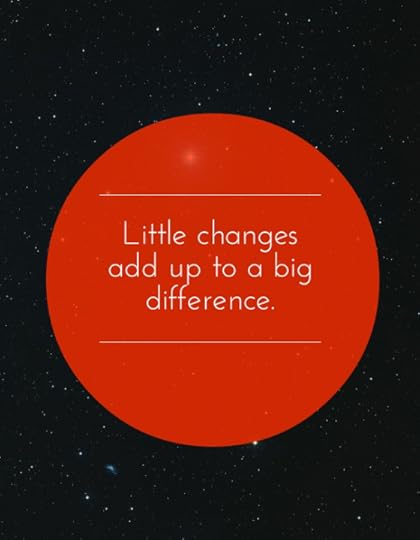
I get asked often how I do it all. How do I teach full-time, have 4 children, a happy marriage, and also write, speak, and all of those other things that I am so lucky to do without losing my mind. And the truth is; I don’t know. There are good days where I feel like I have succeeded in most things and there are days where I feel woefully overworked. There is definitely a chase of balance always going on. Yet, there are some things that have simplified my teaching life that I now take for granted. Things that used to take up a lot of time that I no longer do or have changed to allow me to not work as much as I used to. Because the truth is; being a teacher is a never-ending job. Your to-do list is never done. There will always be one more thing that should get done, one more idea to try. Knowing that, I knew I needed to change a few things, in and out of the classroom in order to save my sanity and have a life.
I stopped grading everything. Or at the very least I stopped grading every single thing that my students created. Kelly Gallagher inspired me to do this specifically with what they wrote but Alfie Kohn inspired me to really think about what grades communicated to my students. The thing is when students expect a grade/score/comment on everything they do, they will never learn to create for the sake of growth (rather than a grade) and they will not become students who can actively reflect on their own learning. When we teach in a way where the teacher has the final word on assessment we cannot create conditions for students to take ownership of their learning. That means that students will continue to look at us to see how they did, rather than realize where on their learning journey they are. (To see more on my moving away from grades journey, go here.)
I stopped decorating the room. I used to spend an inordinate amount of time refreshing the room with great new bulletin board displays, changing out student work, and lining up new visuals for the students. Yet my students never seemed to appreciate it much or even notice it. So by student request we formed a student bulletin board committee who took charge of what they wanted to display. Student work is no longer displayed by me, but instead shared with classrooms around the world for feedback through Google and Skype. Anchor charts are made with the students and then removed when we do not need them. We now relish the bare walls that surround us as we try to create an oasis of calm in the classroom. And the time I spent on setting up the classroom to look cute is now spent on other things.
I shut the door. At school, we have an unspoken rule that if someone’s classroom door is shut, they are busy working. Seldom do we interrupt them during that time. While I adore my colleagues (I work at an amazing school with an amazing team), I also know that once we get started on stories, most of my prep will be gone and that is not fair to my own kids at home. So whenever I have a lot to do, I shut the door and get to work. This way the time we are actually given at school is used better.
I wrote down 3 things. My to-do list is usually about 10/15 items long for various things at school and home, yet when I looked at it, I always gravitated toward the easiest things to check off, leaving the longer tasks for “later.” Now I prioritize 3 things that must get done that day and one of them has to be a “harder” task. Once those 3 things are done for the day I can focus on anything else I can do that day. As for the to do lists, I keep a bullet journal that I absolutely treasure. This method of keeping track of my life has worked well for me and has also been a great way to keep memories fresh. I no longer feel like the to-do list in itself is another to-do.
I stopped multi-tasking. I thought I was the queen of successful multi-tasking until I realized how little I got done. Research has shown that our adult attention span is now 8.25 seconds ( a goldfish has 9 seconds) and I wanted to combat that with setting better work habits. So now when I work I close all of my tabs on the computer, turn off the TV or music, and actually focus on getting to work.
I set a timer. I seem to have two ways of doing work; right away or a very long time from now. And yet, I am under deadlines for writing two new books, I have projects to look at and also lessons to plan. So now when I dread a task or feel like I am in a writing slump, I set a timer for 30 minutes. During that entire 30 minutes I am not allowed to do anything but work, this ties in with the no multi-tasking. The thing is with 30 minutes that anyone can spend 30 minutes on something without losing an entire evening. That is not very long and so it tricks my brain into thinking it is manageable. I often find when the time is up I continue working simply because I am now in a groove.
I cut down my email replies. In these days of instant communication, we all seem to get a lot of email. I can only imagine what administrators must get, and I often felt the need to write lengthy replies back typically with various niceties interjected. Yet that is not efficient, to say the least, so I now go by the two-line reply rule. If a matter needs more than 2 lines to be addressed then I either propose a phone call or a meeting. If it is someone I can speak to at school, I try to find them at some point to discuss, and if it does need a lengthier reply then I wait until I have the time to write it well. I also try to be cognizant of how many emails I send in a day; are they really needed or can a quick phone call or face to face conversation handle it instead?
I stopped planning the whole lesson. Now when I plan, I plan the initial steps and then discuss with my students as we flesh out the plan for the long run. This means that they have input, leading to better buy in, and it also means that it becomes more personalized. Planning with my students means that I do not have to have every single little thing figured out, leaving me more time to focus on the big picture.
I got rid of my book check-out system. Even with the advent of electronic check out systems, it was simply one more thing to manage. Now when students want to borrow a book, they simply borrow it. They do not have to ask, nor do they have to write it down somewhere. The only exception is if they borrow a hard cover book, then they write their name on a post-it and stick it on the dustcover which they then hand to me. I keep track of them until the book is handed back and the dustcover is put back on.
I stopped committing right away. I am very good at saying yes; if you email me a request, chances are that my instant reply would be a yes. A yes means that I can delete the email, a yes means I know what to do. Yet a yes also meant that I now had one more thing to do. Now instead of answering right away, I spend time mulling it over and really think about something before I commit to it. This may seem simple but it has been incredible for me. By not rushing to make a decision, I preserve my energy for the things that matter the most to me. I do not feel guilty when I have to say no because that means I get more time with my own kids. And when I do actually say yes to something, it means I am excited to do it. I use this approach for almost all requests that come to me, big or small.
I stopped trying every new idea. I used to think that to be an innovative teacher I had to try every new big idea that was presented to me. Yet, that just means that you work a lot more on things that may not fit into the vision you have. Now, I pick and choose, I do not feel guilty that I have not gamified our classroom or created a makerspace. We do things in a way that works for us. That doesn’t mean I am apposed to new ideas just that I know to only pick a few and to try them out when I can. The same goes for technology; I would rather pick a few tools to use a year and use them well then try many new ones and not know them.
I removed apps from my phone. I removed email notifications and certain apps like Facebook and Twitter off of my phone last tear and I have not missed them. I did not realize how much time I was spending checking in mindlessly. I felt like I was always on, because I was. Now when I check my email I am cognizant of the time I am using, the same goes for anythig with social media. My own children and those I teach deserve me to be present, and I cannot be if I am constantly drawn to the ding of my phone.
Awhile ago, I wrote a post on how balance is much like a unicorn; wonderful to imagine even though it doesn’t exist. And while I still believe that to be true, I do know that there are better ways to balance being a teacher and everything else. So what have you done to reclaim your life from your constant to-do?
PS: My friend Angela Watson is a master at reclaiming work time, I have much to learn from her.
If you like what you read here, consider reading my book Passionate Learners – How to Engage and Empower Your Students. Also, if you are wondering where I will be in the coming year or would like to have me speak, please see this page.
Filed under: aha moment, balance, Be the change, being a teacher, being me


January 16, 2016
Picture Books in the Middle School

I feel like a broken record lately. Always replying with the same answer as if I cannot think of anything else to say. Yet it is not because my brain is broken or because I do not know enough about teaching English. The truth is that when most people ask me how to teach something in reading or writing, my answer continues to be, “Have you tried a picture book?”
Picture books have become the foundation of the 7th grade English classroom that I am a part of. They are the ice breakers that provide us with the sense of belonging, the sense of community, the sense of wonder that should always surround books and literacy.
They are the life lines I give to students when their day is on the wrong track or they simply need a break.
They are the tool I use to teach close reading, to work through Notice and Note. They are our mentor texts for writing, for how to capture fickle audience and keep their attention while still going deep. They are the springboard into longer texts, the spark that gets us going.
They are the texts I reach for when I do intervention, allowing a child to not fear the text we will discuss so we can focus on the skills we need to work on. They are the texts that surround us when our brains are overwhelmed and we need to just take a moment to get into the groove of learning.
When a child speaks limited English, we reach for wordless books where they can practice inferring without being stumped by the language they are learning.
When a child does not understand what it means to analyze, we reach for familiar texts so we can get to the heart of the story.
Picture books disarm.
Picture books charm.
Picture books teach students that they can be successful readers with meaningful texts. That they can write serious pieces in short bursts. That there is no such thing as too old for a book. That the skills they need to develop can be found within the pages of something that looks like it is just for little kids but clearly is for all.
So when you enter our classroom you will see them beckoning to be read, to be shared, to be contemplated and to be used. You will feel the pull of the books as they call to you, begging you to be read. And so we do, and we grow, and we laugh, and we share these stories that mirror our own or bring us into a new world.
So why picture books? Because they have made the single biggest difference in the life of this teacher. Because my students no longer fear reading, nor can they hate it nearly as much. Because without them I would be constantly scrambling for a short text that we could read in our limited time together and still leave time for discussion.
Who would have thought that all of these things could be taught through the pages of a picture book?
To see which picture books we love, go here.
If you like what you read here, consider reading my book Passionate Learners – How to Engage and Empower Your Students. Also, if you are wondering where I will be in the coming year or would like to have me speak, please see this page.
Filed under: being a teacher, books, Literacy, picture books, Reading


January 15, 2016
A Most Important Question
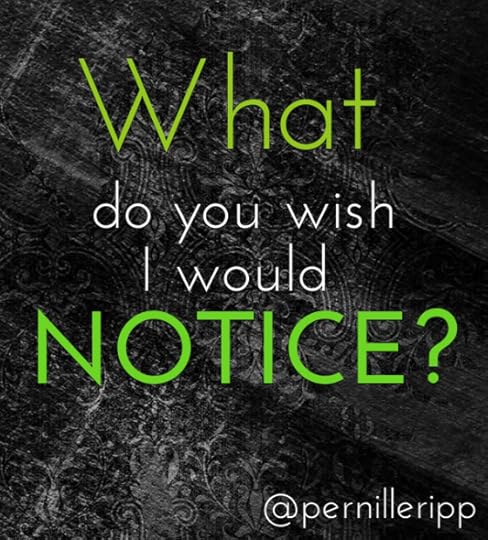 Asking my students to reflect, to give feedback, to set goals and try to peek into their minds has been a mission of mine for the last many years. The questions I ask change, but the purpose does not; to create a better educational experience for them. To create a classroom they actually want to be a part of. To find out how I can change so that I can be a better teacher.
Asking my students to reflect, to give feedback, to set goals and try to peek into their minds has been a mission of mine for the last many years. The questions I ask change, but the purpose does not; to create a better educational experience for them. To create a classroom they actually want to be a part of. To find out how I can change so that I can be a better teacher.
For all of the questions I have asked, and it has been a lot so far, there is one that stands out. One that has given me the most significant answers. One that has led me to question myself and what I focus on in the classroom, day after day, student upon student.
And it is one of the simplest ones indeed.
What do you wish I would notice?
Tucked at the end of the survey, when they are already thinking, when they have already shared.
Some write nothing, some say I am noticing what I need to. But then there are the others, those whose answers always stop me, change me, and sometimes even keep me up at night.
I wish Mrs. Ripp would notice how hard I am trying.
I wish she would notice that I am funny.
I wish she would notice how tired I a.
How I need help.
How I don’t know what to say.
How shy I am.
And I am grateful for their answers, for their faith in me to now begin to notice so that I can be better. So that we can be better. So that school can be about them again, just the way it was meant to be.
If you like what you read here, consider reading my book Passionate Learners – How to Engage and Empower Your Students. Also, if you are wondering where I will be in the coming year or would like to have me speak, please see this page.
Filed under: being a student, being a teacher, being me, questions, student choice, Student dreams, student driven, student voice, Student-centered


January 13, 2016
Broken Child
She’s got my eyes, you know.
Blue mixed with gray depending on the weather. She’s got my long legs, arms for miles, and a laugh that comes from her heart. Her hands look like my grandfather’s who gave her her name. And those feet of hers are just like mine, growing too fast for her shoes to keep up.
She’s got her daddy’s sense of humor, always ready to make you smile. And also his artistic eye, declaring one day she will be an artist. She will paint the sky with every color she knows.
But she doesn’t have my skills of sitting still. Of staying quiet. Of focusing in.
She doesn’t smile easy or understand when others are kidding. Friendships are sometimes hard to find.
Some would say she is a broken child. Some would say she is a broken child.
We come up with fixes to help her learn more. To help her sit still. To help her conquer the noise of the classroom. We give her fidgets, wiggle seats, quiet time and breaks. And when we run out of fixes we ask more people for help.
And I cry sometimes when I think of how hard she works to gain knowledge that came so easy for me. I cry sometimes when I think ahead because sometimes as a teacher your curse is that you know too much and so you worry even when others wouldn’t.
She’s got my eyes, you know, but not the way I think and some would say she is a broken child.
So we stand in our kitchen discussing the latest reports, the latest assessment, and we thank our lucky stars that the teachers she has sees what we see. A child with heart. A child that loves. A child that wants nothing else but to fit in and feel smart.
And yet, when we compare her to others, even though I know we shouldn’t, some may say she needs fixing. That we just need to find the thing that makes her right. That perhaps the doctor knows why she cannot sit still, why she cannot stay focused, why she cannot find friends easily. Because surely something must need fixing.
And I know that sometimes I feel like I failed. Like somehow I created this situation. That perhaps in her childhood if I had only done more, she would have it easier. But then I remember that my child is not brokoen. That my child does not need to be fixed.
That she is smart.
That she is kind.
That she works hard.
Even when her brain distracts her every step of the way.
And I know she is not a broken child.
And I know she is not a broken child.
Filed under: being a teacher


January 12, 2016
Great Picture Books for Martin Luther King Jr. Day
Martin Luther King Jr day, held on the third Monday of January every year, is rapidly approaching. This year, I will be in class teaching, last year I was not. And while I believe that we should not just teach about MLK Jr or any other history related to the civil rights movement on this day, I find that many look for resources for this day in particular. I, of course, have been searching for picture books to use with my students as we try to learn more about our country’s past and think of the changes we can make right now.
Some of these I already have, others are on my much too long wish list. One day they shall all find their rightful place in our classroom. Some of these are directly related to the life of MLK Jr, others are related to the movement, but they will all add to our knowledge of America then so we can better understand America now.
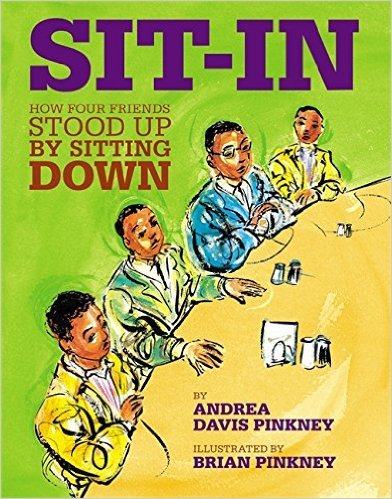
From Amazon:
It was February 1, 1960.
They didn’t need menus. Their order was simple.
A doughnut and coffee, with cream on the side.
Sit-In: How Four Friends Stood Up By Sitting Down by Andrea Davis Pinkney and illustrated by Brian Pinkney is a celebration of the 50th anniversary of the momentous Woolworth’s lunch counter sit-in, when four college students staged a peaceful protest that became a defining moment in the struggle for racial equality and the growing civil rights movement.
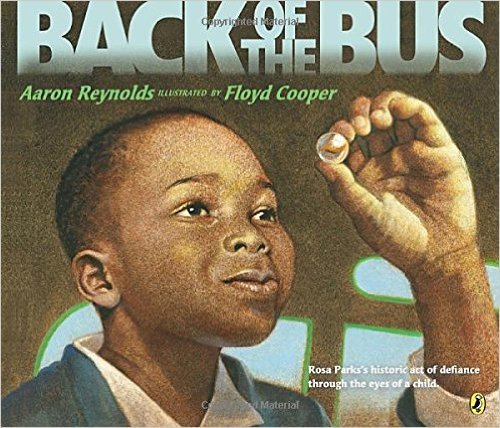
From Amazon:
It’s December 1, 1955.
A boy and his mother are riding the bus in Montgomery, Alabama like any other day—way in the back of the bus. The boy passes time by watching his marble roll up and down the aisle with the motion of the bus…
Until a big commotion breaks out from way up front.
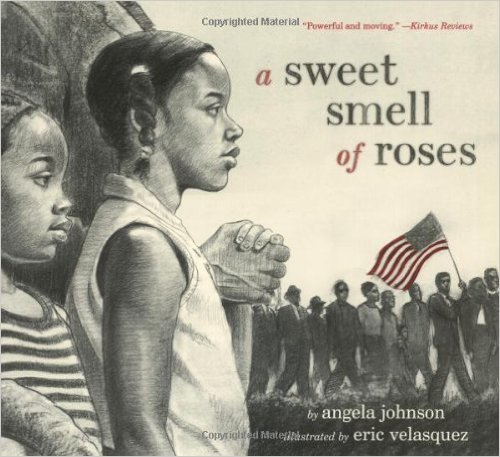
I have cherished my copy of A Sweet Smell of Roses by Angela Johnson and illustrated by Eric Velasquez for years. This is also a great picture book for teaching theme and inference.
From Amazon:
There’s a sweet, sweet smell in the air as two young girls sneak out of their house, down the street, and across town to where men and women are gathered, ready to march for freedom and justice. Inspired by countless children and young adults who took a stand, two Coretta Scott King honorees offer a heart-lifting glimpse of children’s roles in the civil rights movement.

I stumbled across Child of the Civil Rights Movement by Paula Young Shelton & Raul Colon and have used it with the students as a way to discuss perspective. I loved the “regular” side of MLK Jr that it presents.
From Amazon:
In this Bank Street College of Education Best Children’s Book of the Year, Paula Young Shelton, daughter of Civil Rights activist Andrew Young, brings a child’s unique perspective to an important chapter in America’s history. Paula grew up in the deep south, in a world where whites had and blacks did not. With an activist father and a community of leaders surrounding her, including Uncle Martin (Martin Luther King), Paula watched and listened to the struggles, eventually joining with her family—and thousands of others—in the historic march from Selma to Montgomery.
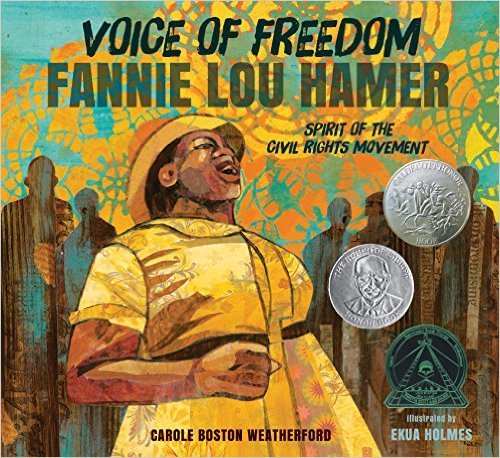
This post would be woefully incomplete without the magnificent picture book Voice of Freedom: Fannie Lou Hamer: Spirit of the Civil Rights Movement written by Carole Boston Weatherford and illustrated by Ekua Holmes. Stunning is a good way to describe and the awards on its cover backs me up.
From Amazon:
“I am sick and tired of being sick and tired.”
Despite fierce prejudice and abuse, even being beaten to within an inch of her life, Fannie Lou Hamer was a champion of civil rights from the 1950s until her death in 1977. Integral to the Freedom Summer of 1964, Ms. Hamer gave a speech at the Democratic National Convention that, despite President Johnson’s interference, aired on national TV news and spurred the nation to support the Freedom Democrats. Featuring vibrant mixed-media art full of intricate detail, Voice of Freedom celebrates Fannie Lou Hamer’s life and legacy with a message of hope, determination, and strength.
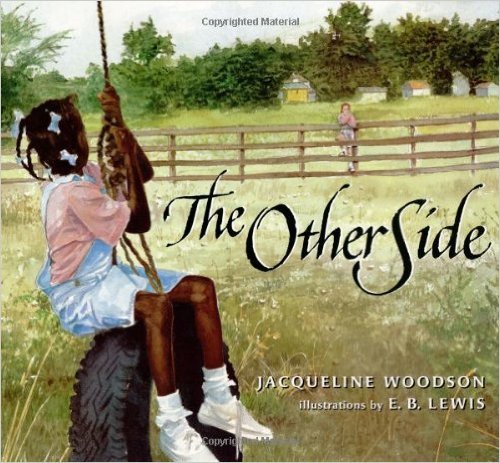
Can there be a picture book list without Jacqueline Woodson’s work on it? The Other Side illustrated by E.B. Lewis is sure to start a poignant conversation with kids.
From Amazon:
Clover’s mom says it isn’t safe to cross the fence that segregates their African-American side of town from the white side where Anna lives. But the two girls strike up a friendship, and get around the grown-ups’ rules by sitting on top of the fence together.
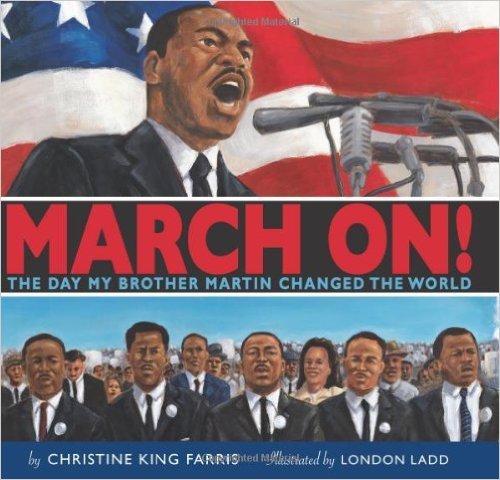
March On! The Day My Brother Martin Changed the World by Christine King Farris and illustrated by London Ladd is on my wish list as well.
From Amazon:
Martin Luther King, Jr.’s, sister remembers the March on Washington.
From Dr. Martin Luther King’s sister, the definitive tribute to the man, the march, and the speech that changed a nation.

White Water by Michael S. Bandy and Eric Stein, illustrated by Shadra Strickland is a picture book I have used several times with students as we have worked through our Notice and Note sign posts. This is another powerful story that lead to more questions that answers.
From Amazon:
It’s a scorching hot day, and going into town with Grandma is one of Michael’s favorite things. When the bus pulls up, they climb in and pay their fare, get out, walk to the back door, and climb in again. By the time they arrive in town, Michael’s throat is as dry as a bone, so he runs to the water fountain. But after a few sips, the warm, rusty water tastes bad. Why is the kid at the “Whites Only” fountain still drinking? Is his water clear and refreshingly cool? No matter how much trouble Michael might get into, he’s determined to find out for himself.
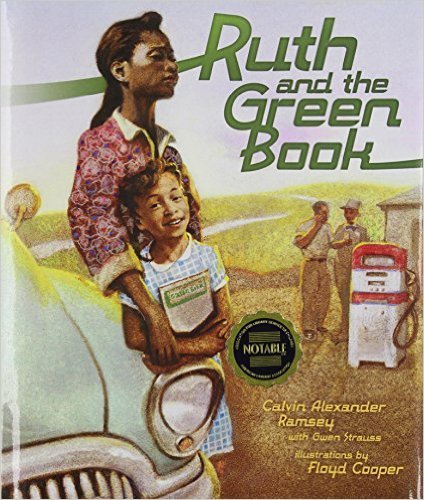
Another eye opening book for students is Ruth and the Green Book by Calvin Alexander Ramsey with Gwen Strauss and illustrated by Floyd Cooper.
From Amazon:
Ruth was so excited to take a trip in her family’s new car! In the early 1950s, few African Americans could afford to buy cars, so this would be an adventure. But she soon found out that black travelers weren’t treated very well in some towns. Many hotels and gas stations refused service to black people. Daddy was upset about something called Jim Crow laws…
Finally, a friendly attendant at a gas station showed Ruth’s family The Green Book. It listed all of the places that would welcome black travelers. With this guidebook–and the kindness of strangers–Ruth could finally make a safe journey from Chicago to her grandma’s house in Alabama.
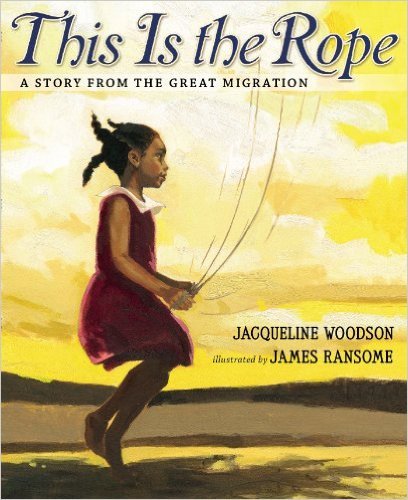
Another Jacqueline Woodson book that has been well loved in our library, This is the Rope always makes me think. Illustrated by James Ransome I love the simple but oh so powerful story it tells of the rope passed through generations, witness to their history.
From Amazon:
The story of one family’s journey north during the Great Migration starts with a little girl in South Carolina who finds a rope under a tree one summer. She has no idea the rope will become part of her family’s history. But for three generations, that rope is passed down, used for everything from jump rope games to tying suitcases onto a car for the big move north to New York City, and even for a family reunion where that first little girl is now a grandmother.
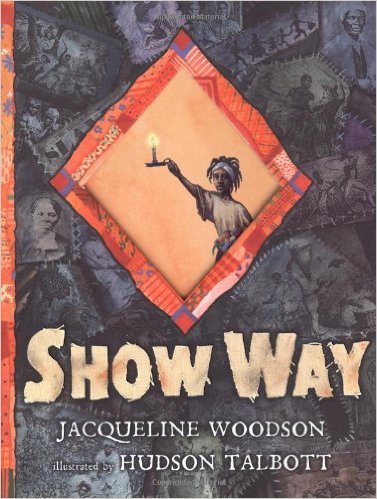
I may as well add one other of my favorite Jacqueline Woodson books; Show Way illustrated by Hudson Talbott. As a mother, I cry when I read this picture book and think of the generations that have passed before us and the injustices some have faced.
From Amazon:
Soonie’s great-grandma was just seven years old when she was sold to a big plantation without her ma and pa, and with only some fabric and needles to call her own. She pieced together bright patches with names like North Star and Crossroads, patches with secret meanings made into quilts called Show Ways — maps for slaves to follow to freedom. When she grew up and had a little girl, she passed on this knowledge. And generations later, Soonie — who was born free — taught her own daughter how to sew beautiful quilts to be sold at market and how to read.
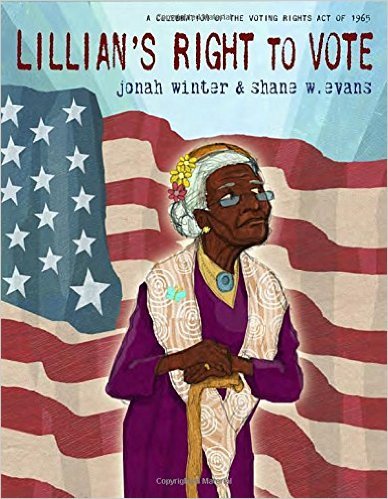
One of our top picture books of 2015, Lillian’s Right to Vote by Jonah WInter and Shane W. Evans is story telling at its finest. In fact, I used this as a mentor text for when my own students wrote their picture books to show how many facts can be woven together.
From Amazon:
An elderly African American woman, en route to vote, remembers her family’s tumultuous voting history in this picture book publishing in time for the fiftieth anniversary of the Voting Rights Act of 1965.
As Lillian, a one-hundred-year-old African American woman, makes a “long haul up a steep hill” to her polling place, she sees more than trees and sky—she sees her family’s history. She sees the passage of the Fifteenth Amendment and her great-grandfather voting for the first time. She sees her parents trying to register to vote. And she sees herself marching in a protest from Selma to Montgomery.
There are so many more that could be highlighted but I wanted to leave it up to others to share their favorites. We have a moral obligation in our classroom to discuss the past of the United States and these picture books help us start those conversations.
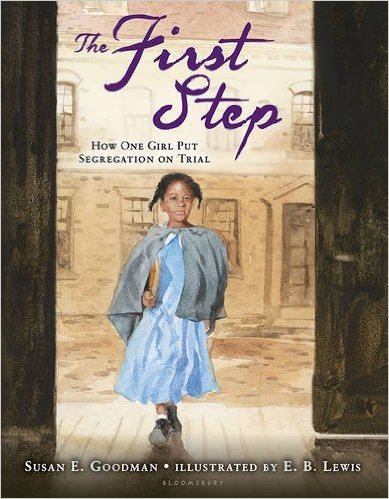
Leave it up The Nerdy Book Club to add more books to my wish list. The First Step by Susan E. Goodman and illustrated by E.B. Lewis just came out last week and looks like a must add to any classroom library.
From Amazon:
In 1847, a young African American girl named Sarah Roberts was attending a school in Boston. Then one day she was told she could never come back. She didn’t belong. The Otis School was for white children only.
Sarah deserved an equal education, and the Roberts family fought for change. They made history. Roberts v. City of Boston was the first case challenging our legal system to outlaw segregated schools. It was the first time an African American lawyer argued in a supreme court.
These first steps set in motion changes that ultimately led to equality under the law in the United States. Sarah’s cause was won when people–black and white–stood together and said, No more. Now, right now, it is time for change!
Filed under: being a teacher, books, Literacy, picture books


January 9, 2016
To the Angry 4th Grader Who Grew Up
There are those students that settle in our hearts through smiles and eagerness. Through always completed work, a willingness to share, and never missing a beat. We easily laugh with them and caring about them is natural. Then there are those kids that march into our hearts. Fists closed in anger, doors slammed in their wakes, bolts of lighting seeping from their eyes. Our rational minds put up a fight with those and yet seemingly while we fought their anger with every bit of kindness we had in us, they carved out the largest bits of us. While we tried every thing we had, they walked right in and took residence in our souls, as if they were always meant to be there. And when we say goodbye, it seems like they take that piece of us with them and we wonder, and we hope, and we worry. Oh we worry. Even though they are no longer ours, they really still are.
8 years ago I taught an angry 4th grader. A child that stomped his way into my heart and stayed there through shouts, vented frustrations, and yet an achingly quiet plea for more kindness, more caring, more understanding emanating from his very core. As we said goodbye at the end of our year, I did not realize just how much of a piece of me he took with him. And his absence from our school after summer is something I will never forget.
I worried about him then and I worry about him now.
We love these kids that we teach even when we shouldn’t. We call them ours, even when they are not. Even when it may seem strange to others that we lie awake worrying about something we have absolutely no control over. We try our very best to make the time we have worthwhile. To make it somehow better well knowing that we will never be able to fight the beasts that swallow some of our students outside of school. I am not a savior, I probably never will be, but I can care, and I can try, and I can make my slice of their world not as hurtful, not as harmful. Even when it seems in vain.
So to the angry 4th grader who is now an angry junior. Whose life was just dealt another blow today. Whose tragedy seems to play out in the headlines rather than become a thing of the past. I didn’t forget about you. I bet I am not the only one. Us teachers are strange like that. I know that I cannot make your life better, I know that I cannot make the wrong things right. I can only care, I can only be, whether you need me or not. So know that. Know that when you cried on the last day of school I cried too. And I cried the day I heard you weren’t coming back. Life may seem like it is worth being angry over but don’t let your anger drown you. You can change the world, but not if you don’t feel like the world is worth changing. I saw something in you those many years ago, I hope you see the same now. You are worth fighting for. You are worth caring for. Don’t let the world make you believe otherwise.
Filed under: being a teacher, being me






